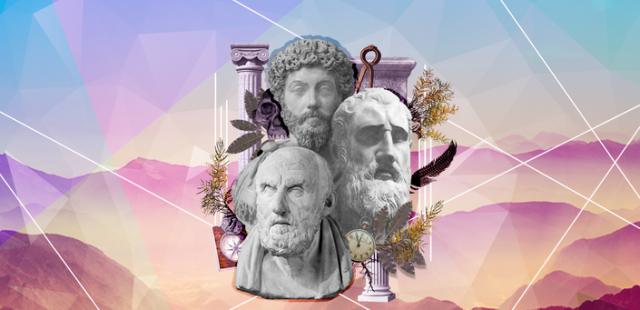Meditation on Past Evils: A Neostoic Spiritual Exercise
by John Sellars
Much has been written about the Stoic idea of premeditation on future evils: pre-rehearse potential bad events so that if they come you are better prepared to deal with them and, if they don’t, be all the more grateful for your good fortune. But what about past evils? Is there anything to be gained from reflecting on evils that have already happened?
In the sixteenth century Justus Lipsius thought there was. Lipsius was a Humanist and committed to Stoicism His On Constancy of 1584 is a dialogue about how Stoicism might help people then caught in the middle of horrific religious wars. He went on to produce an important edition of the works of Seneca in 1605 and published with it two volumes that, for the first time, tried to bring together all the surviving evidence for the early Stoics, in 1604. In the history of Stoicism he is probably the most important figure after the ancient Stoics.
Lipsius’s On Constancy is an attempt to offer remedies for public evils, that is suggestions to help people trying to cope with adverse situations out of their control. One of his remedies tries to show that the public evils then afflicting people are, when put into an appropriate historical context, neither especially grievous nor unusual. Lipsius the Humanist thinks that the study of history can offer us therapeutic benefit. What follows is somewhat brutal, but that is part of the point. Lipsius recounts the death tolls of wars recorded in ancient historians. In the wars of the ancient Jews 20,000 died at Caesarea, 13,000 at Scythopolis, 2,500 at Ascalon, 2,000 at Ptolomais, 50,000 at Alexandria, 10,000 at Damascus, and so on and on. He then turns to Greek and Roman history. Drawing upon the ancient historian Procopius and other sources, Lipsius continues with graphic descriptions of ancient plagues and famines, of which just one gruesome example from a famine should be enough: ‘Two women (I quake to speak it) killed seventeen men in the night by treachery and did eat them; at length they themselves were slain by the eighteenth, who perceived the matter.’
Cruelty is nothing new either, Lipsius says, citing examples from the historian Valerius Maximus. Lipsius draws on his impressive knowledge of ancient history and literature to furnish us with numerous examples to support his claim that public evils such as civil war, tyranny, famine, and plague are by no means limited to the present age. All of these public evils are constant features of history and so we should not be surprised to find them in our own time. Indeed, it would be truly miraculous if our own time were exempt from such events. All countries and all ages have had their share of public evils; so must our country and our age.
This strategy involves a version of an idea known as ‘moral distance’. This is the idea that we tend to care more for those things closer to us than those far away, and it is traditionally credited to David Hume. Our natural sympathy for those closest at hand, it is suggested, is a distortion that we must overcome when making moral judgements. Lipsius’s version is different though: his aim is to show that moral distance can distort our perception of public evils, making our own immediate troubles appear much more significant than they actually are. If we step back and consider those evils within a wider historical context we shall see that in fact they are neither especially grievous nor unusual. This shares something with what Pierre Hadot called ‘the view from above’, but in this case proposing a wider historical perspective rather than a wider geographical view.
Lipsius was not wrong when he said that all ages have their share of public evils. For us the Holocaust has come to be seen as the archetypal example, and for good reason. Reflecting on horrific events from the past such as the Holocaust is important for a number of obvious and well-known reasons: some things should never be forgotten. For Lipsius this sort of reflection on past evils can also be a chilling way to put our current troubles into stark perspective.

One of the infamous piles of shoes, representing the scale of human loss focalised through the normal and every-day.
John Sellars is currently a Research Fellow at King’s College London. His principal area of research is Ancient philosophy, but he is equally interested in its later influence and have wide interests in Medieval, Renaissance, and Early Modern philosophy. He has written two books on Stoic philosophy:Stoicism and The Art of Living. Read more about John’s work on his website, and also see his blog on Stoicism.





Very interesting, but I have never understood Marcus Aurelius “View from above” as referring only to a geographical view but rather as getting an emotional distance both in space and time so as to retain one’s equanimity.
Lipsius is an interesting individual. Trying to marry Christianity and Stoicism while being willing to change his loyalty to whichever branch of Christianity was prominent in the place that he was living at any given time.
It would appear that his advice to rulers was to persecute any dissent and it was just such persecution that had led to the very suffering he was saying was to be found throughout history and so could not be avoided in the present day.
No wonder he advised ‘the people’ to accept such suffering – he was advising the rulers to cause it.
At least Neostoicism is still accepting the idea of a deity, albeit that it is appears to deny that the Stoic deity and the Christian deity (and all deities for that matter) are one and the same.
As to this article, it is totally misleading. Of course it is advisable to learn from history – not to just accept what happens, but to improve matters in the future. Acceptance of what has been and how things are at any given moment is only the starting point of practicing Stoicism. Working with Nature in trying to work towards the better is the aim of Stoicism.
This article offers pessimism – it has always been this way and things will never change. Rubbish!
Stoicism offers optimism through Providence and the ability to rise above mankind’s stupidity and Natures necessities (such as earthquakes and the like). It encourages even temperament – not a total lack of any feelings as seems to be what Lipsius suggests.
Thank you for this interesting piece. Whilst it is necessary to be aware of sad past events and never forgot them, I would be concerned about how this may be interpreted by some. A pessimistic, anxious or depressed person could perhaps do harm by ruminating on such matters and I don’t think this would be a very Stoic approach. If one is experiencing personal suffering the idea of adding further to that burden by hyper-reflection on others’s personal suffering could be detrimental. I also practise Stoicism through the eyes of an optimist, and don’t view it as a pessimistic philosophy for life.